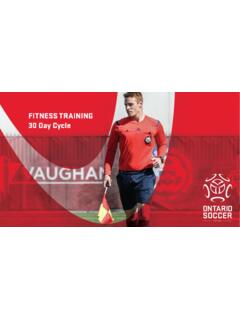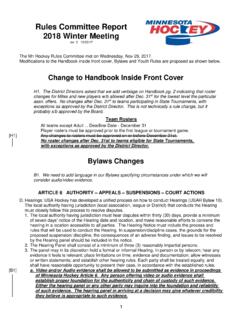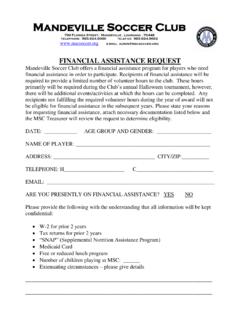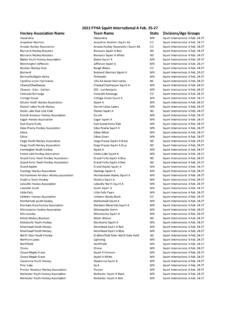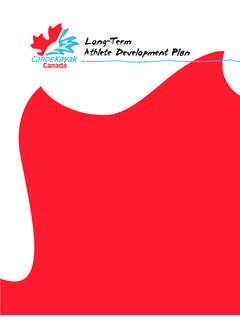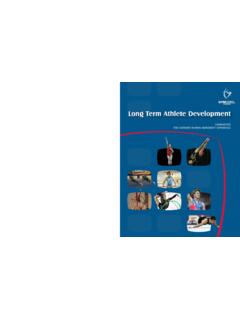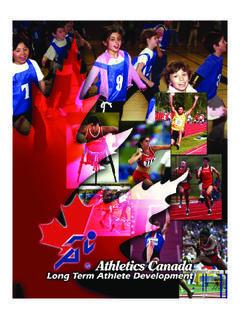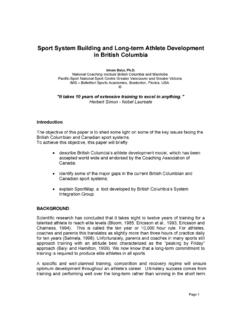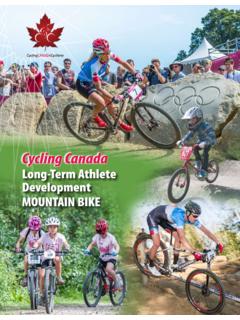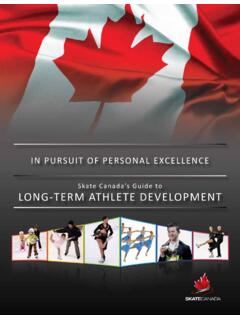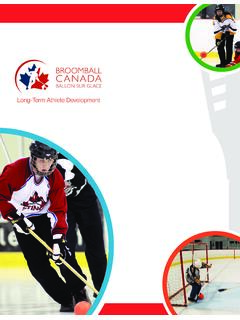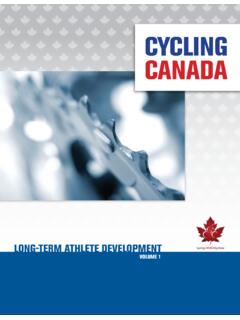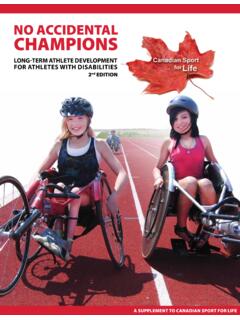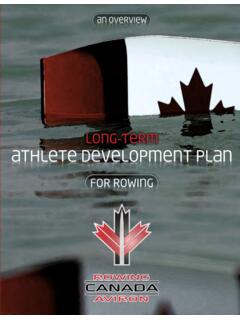Transcription of USA Hockey Model - cdn4.sportngin.com
1 USA Hockey Model long -Term Athlete development Stages FUNdamentals Late Childhood M 6-9 years F 6-8 years 8 and Under Mites Speed, agility and coordination are still improving rapidly during this phase. With this improvement of fine motor movement all core skills can be introduced and mastered. This is the key phase for learning good technique, and so quality training, including applying skills in game scenarios, should take precedence over competition results. This is reflected by an emphasis of 70% training, 10% competition specific training1 and 20% competition2. Research shows that failing to utilize this period of growth for skill development will mean that a player is unlikely to reach his or her full potential.
2 Players should learn how to train during this phase, and be encouraged to understand the need to develop fitness, Hockey skills and tactical awareness in all playing positions. Players will be developing the mental capabilities to enable decision making in more complex game situations. Participation in complementary sports will enhance players learning and understanding of skills and decision making in games. Young people are still more suited to longer bursts of low intensity activity at this phase of their development , but will also be undergoing growth spurts that will affect coordination. Once their body has adapted, skills may need to be re-learned or refined as a result of these changes in relative limb lengths. Players will be developing physically and mentally at different rates so chronological age ( from birth date) may not be the most appropriate way to group players.
3 As much as possible, players should be given individual specific direction and structure within their training to recognize that development is occurring at different rates for each player. Evaluators should avoid choosing early physical developers simply because they are stronger or faster a rounded view of players long -term potential should be encouraged. Learning to Train Early Puberty M 9-12 years F 8-11 years 10 and Under Squirts 12 and Under Peewee The objective of the FUNdametals stage is to learn all fundamental movement skills and build overall motor skills. This phase of growth and development is characterized by rapid growth. Generally larger muscle groups are better developed which makes it easier for players to perform large movements rather than precise coordinated movements involving the interaction of many smaller muscles.
4 Consequently the emphasis should be on developing basic movement skills in a fun way the FUNdamentals: ABCs: Agility, Balance, Coordination, Speed RJTs: Running, Jumping, Throwing KGBs: Kinesthetics, Gliding, Buoyancy CPKs: Catching, Passing, Kicking, Striking Young people should be encouraged to learn simple sports skills, including striking skills to develop hand-eye coordination and gliding skills to improve balance and coordination. Activities and games should emphasize coordination and learning through repeating movement, but as attention spans are short, variety and structure are essential. As there is little difference developmentally between girls and boys at this stage, mixed activities are encouraged. Participation in a variety of activities and sports helps to develop basic movement skills, and endurance can be developed through playing fun games and activities.
5 Young people are more suited to longer bursts of low intensity activity at this stage of their development , rather than short bursts of high intensity activity. The emphasis must always be on FUN rather than winning. The first window of accelerated adaptation to speed occurs at ages 6 to 8 for girls and 7 to 9 for boys. Bypassing the specialized skill development in the FUNdamentals stage is detrimental to the child s future engagement in physical activity and sport. 1 Competition specific training is scrimmaging, exhibition games, etc. 2 Competition is sanctioned competition, league play, tournaments, playoffs, etc. USA Hockey Model long -Term Athlete development Stages Training to Train Late Puberty M 12-16 years F 11-15 years 14 and Under Bantam 16 and Under Midget This is also an important phase for fitness development , particularly for strength.
6 The content is intended to reflect the degree of commitment required to continue a players development either as a recreational or an aspiring elite player. The development of skills and mental capabilities will be well advanced in players at theses age groups so it is appropriate for more emphasis to be placed on competition, demonstrated by a 50% training, 25% competition specific training and 25% competition ratio. In the early part of this phase, the emphasis within competition should still be to reinforce learning, with a gradual shift to a more outcome drive emphasis. A players ability to perform core skills and make decisions within a game situation have reached a standard at which tactical strategies can be properly applied in order to try to overcome opposing teams, at these age levels.
7 Training will include more specific preparation for competition. Learn to Compete Early Adult M 16-18 years F 15-17 years 18 and Under Midget Research shows that this phase of development is key for the development of various aspects of fitness. Toward the end of this phase, young players will be better able to deal with the demands of short bursts of higher intensity activity required for Hockey . The latter end of this phase of development is the ideal time for developing speed and strength using body weight exercises, but this should be part of a program tailored to the individual due to differing rates of growth and maturation. The emphasis should remain on training during this phase, reflected in a ratio of 60% training, 20% competition specific training and 20% competition.
8 This is also a prime skill development period, but due to better developed mental capacities, players will be more able to train under realistic game pressure, applying core skills to develop decision-making ability in a variety of playing positions. Competition should be used only to reinforce learning and refine the application of skills, not concentrate on the games outcome. Young players should ideally undertake competition only with peer groups at this delicate period of their development . As with the previous phase of development , research shows the need for physical (fitness) preparation and skill development is critical here. This will result in an increase in the training demands on young players. However, for Hockey training sessions should be structured to perform the dual function of working on aspects of fitness alongside skills.
9 Additionally, the recommendations should be viewed as a weekly program that may be obtained via a number of different sources, school PE, club or other Hockey coaching, and participation in complementary sports, which is still to be encouraged at this stage. It is for this reason that efforts should be made to manage individual players sporting, academic and social commitments in order to achieve balance. This is particularly important for talented players who may be accessing coaching via a number of different sources, potentially in more than one sport. This is the stage at which the draft LTAD Hockey Model differentiates its content to provide guidance for all those who play Hockey (standard content) and those who aspire to become elite performers (high performance content).
10 It is recognized that at these ages there is still very little difference in recommended content as this is such an important age and many players still possess the potential to become elite performers. USA Hockey Model long -Term Athlete development Stages Training to Compete Early Adult M 19-23 years F 18-21 years Junior, NCAA This is the final stage of athletic preparation. Skill and tactical preparation will be tailored for competitions, with ratios reaching 40% training, 20% competition specific training and 40% competition. With all skill and tactical abilities fully developed, emphasis can now be placed on achieving the best possible performance in competition.

